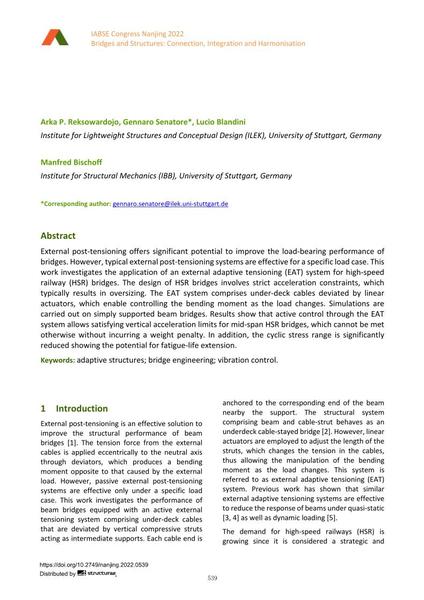Vibration Control of Simply Supported Beam Bridges Equipped with an Underdeck Adaptive Tensioning System

|
|
|||||||||||
Détails bibliographiques
| Auteur(s): |
Arka P. Reksowardojo
(Institute for Lightweight Structures and Conceptual Design (ILEK), University of Stuttgart, Germany)
Gennaro Senatore (Institute for Lightweight Structures and Conceptual Design (ILEK), University of Stuttgart, Germany) Lucio Blandini (Institute for Lightweight Structures and Conceptual Design (ILEK), University of Stuttgart, Germany) Manfred Bischoff (Institute for Structural Mechanics (IBB), University of Stuttgart, Germany) |
||||
|---|---|---|---|---|---|
| Médium: | papier de conférence | ||||
| Langue(s): | anglais | ||||
| Conférence: | IABSE Congress: Bridges and Structures: Connection, Integration and Harmonisation, Nanjing, People's Republic of China, 21-23 September 2022 | ||||
| Publié dans: | IABSE Congress Nanjing 2022 | ||||
|
|||||
| Page(s): | 539-548 | ||||
| Nombre total de pages (du PDF): | 10 | ||||
| DOI: | 10.2749/nanjing.2022.0539 | ||||
| Abstrait: |
External post-tensioning offers significant potential to improve the load-bearing performance of bridges. However, typical external post-tensioning systems are effective for a specific load case. This work investigates the application of an external adaptive tensioning (EAT) system for high-speed railway (HSR) bridges. The design of HSR bridges involves strict acceleration constraints, which typically results in oversizing. The EAT system comprises under-deck cables deviated by linear actuators, which enable controlling the bending moment as the load changes. Simulations are carried out on simply supported beam bridges. Results show that active control through the EAT system allows satisfying vertical acceleration limits for mid-span HSR bridges, which cannot be met otherwise without incurring a weight penalty. In addition, the cyclic stress range is significantly reduced showing the potential for fatigue-life extension. |
||||
| Mots-clé: |
structures adaptives
|
||||
| Copyright: | © 2022 International Association for Bridge and Structural Engineering (IABSE) | ||||
| License: | Cette oeuvre ne peut être utilisée sans la permission de l'auteur ou détenteur des droits. |
||||
